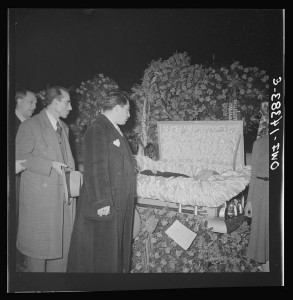
Photo taken by Marjory Collins, 1943, “New York, New York. Mourners at the funeral of Carlo Tresca, the Italian anarchist publisher of Il Martello, who was murdered on Fifth Avenue. The funeral was held in Manhattan Center and was attended by over 5000 anti-facists.” From Library of Congress: Farm Security Administration – Office of War Information Photograph Collection.
The above photo is from Carlo Tresca’s funeral, a prominent Italian-American anti-fascist and journalist. The photo was taken in 1943 by Marjory Collins, a photojournalist working for the US Office of War Information during the Second World War focusing on ethnicities on the home front. The title of the photo tells that thousands of people came out to Tresca’s funeral thus showing his importance in the Italian-American community. In America, leading up to Italy’s conquest of Ethiopia, parts of the Italian American community were supportive of the fascist dictator, Benito Mussolini.
Much of this changed though when Pearl Harbor was attacked and America entered WWII. Italian-American anti-fascism was revived, with Tresca as their icon. Meanwhile America readied itself for war and the pro-fascist parts of the Italian-American community caught up in Mussolini’s campaign of national pride had to reevaluate its stance on fascist Italy. Many Italian immigrants that came to America were fleeing the violence and oppression of Mussolini’s reign, because of this these rallied behind Tresca and the anti-fascism movement. Anti-fascist groups got help fighting their opposition when fascist groups in America were being suppressed by American government groups. The war was pivotal for Italian-Americans as they started to embrace their new status as Americans and turn away from their old loyalties.
References
Mangione, Jerre, Morreale, Ben. La Storia: Five Centuries of the Italian American Experience. New York: HarperCollins Publishers, 1992.
Pernicone, Nunzio. Carlo Tresca Portrait of a Rebel. New York: Palgrave MacMillian, 2005.
